Jai Arjun Singh's Blog, page 3
August 9, 2025
Some gushing about John Dickson Carr (The Black Spectacles, She Died a Lady, etc)
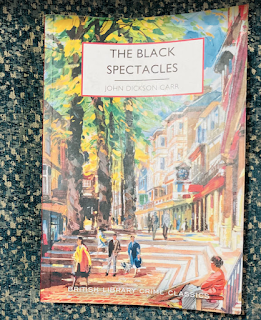 I have got back to reading John Dickson Carr mysteries from what is generally regarded his peak phase (mid-1930s to mid-40s) – a few of these can now be bought online at not horrendous prices, and delivered within a week or two. (Reading e-books is still not my thing, at least not for cosy Golden Age crime fiction.) Finished and greatly enjoyed his 1939 novel The Black Spectacles over the course of a day. Premise: a nasty episode of poisoning in an English village results in suspicion and hostility directed at a young woman – and is followed a few months later by a strange experiment conducted by this woman’s uncle at his country house, apparently to prove to a small audience that they can’t always trust the evidence of their eyes. (A Hindi translation of this book could be titled Ankhon Dekhi.) Of course, a second murder takes place at this demonstration – practically in front of everyone’s eyes, but with no clarity about exactly what transpired – and soon the formidable, harrumphing Dr Gideon Fell is called in to investigate.
I have got back to reading John Dickson Carr mysteries from what is generally regarded his peak phase (mid-1930s to mid-40s) – a few of these can now be bought online at not horrendous prices, and delivered within a week or two. (Reading e-books is still not my thing, at least not for cosy Golden Age crime fiction.) Finished and greatly enjoyed his 1939 novel The Black Spectacles over the course of a day. Premise: a nasty episode of poisoning in an English village results in suspicion and hostility directed at a young woman – and is followed a few months later by a strange experiment conducted by this woman’s uncle at his country house, apparently to prove to a small audience that they can’t always trust the evidence of their eyes. (A Hindi translation of this book could be titled Ankhon Dekhi.) Of course, a second murder takes place at this demonstration – practically in front of everyone’s eyes, but with no clarity about exactly what transpired – and soon the formidable, harrumphing Dr Gideon Fell is called in to investigate.As most serious crime buffs know, Carr’s reputation and popularity were once almost at Agatha Christie’s level – but he never became a bestselling author worldwide on anything like the scale she did, and many of his books are very hard to obtain today. (One reason may be that some things about Christie’s work – the simplicity of her prose, the tidiness of her plotting – travelled and endured better; so that she was more accessible to readers outside the Anglophone world, including those for whom English wasn’t a first language.)
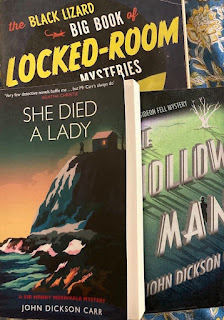 Something I struggle to articulate about the effect of my favourite Carr novels: I am not usually blown away by the denouement – I mean, I do appreciate the skill and craft, and how carefully plotted the thing was, but it doesn’t necessarily build up to a specific “oh wow!” moment that you sometimes want from a whodunit. At the same time, I can see that this could be because Carr has so much going on simultaneously that his solutions tend to be long and winding, covering much terrain, and you can’t distill the finale to a single gasp-inducing revelation (“They *all* did it!” or “The detective is the murderer!”) More importantly: the fact that the reveal isn’t the most thrilling part of the book – the build-up and the anticipation are more exciting – doesn’t take away from my enjoyment of the whole. Carr is great at creating some genuinely unsettling, creepy moments early on, which work entirely on their own terms as atmosphere-generators for the mystery. (Take the beginning of The Hollow Man, with a masked man gaining entry to a private club and having an enigmatic interaction with one of the patrons.)
Something I struggle to articulate about the effect of my favourite Carr novels: I am not usually blown away by the denouement – I mean, I do appreciate the skill and craft, and how carefully plotted the thing was, but it doesn’t necessarily build up to a specific “oh wow!” moment that you sometimes want from a whodunit. At the same time, I can see that this could be because Carr has so much going on simultaneously that his solutions tend to be long and winding, covering much terrain, and you can’t distill the finale to a single gasp-inducing revelation (“They *all* did it!” or “The detective is the murderer!”) More importantly: the fact that the reveal isn’t the most thrilling part of the book – the build-up and the anticipation are more exciting – doesn’t take away from my enjoyment of the whole. Carr is great at creating some genuinely unsettling, creepy moments early on, which work entirely on their own terms as atmosphere-generators for the mystery. (Take the beginning of The Hollow Man, with a masked man gaining entry to a private club and having an enigmatic interaction with one of the patrons.)That said, The Black Spectacles does have a satisfying and well-worked-out solution; nothing to quibble with on that front. It’s just that I find other parts of the book equally or more compelling – such as the speculation around the possible ways that regular chocolates at a sweet-shop could have been replaced with poisoned ones, or the opening chapter which presents a view of some of the central characters during a trip to Pompeii (as seen through the eyes of a young detective who will later get involved in the case).
P.S. Carr’s most celebrated work is probably The Hollow Man (also published as The Three Coffins), but I tend to agree with Carr aficionados who consider this novel overhyped. (My reasons: engrossing and atmospheric though the book as a whole is – certainly worth a second read – the final explanation is too long and complicated, and I think it can be argued that Carr “cheats” a bit when it comes to the chronology of events in the story; or at least holds back a piece of information that makes it almost impossible for a reader to work things out.)
What The Hollow Man does have going for it – and this is a big reason for its reputation – is an almost standalone chapter titled “The Locked-Room Lecture”, in which the voluble Dr Gideon Fell holds forth on “the general mechanics and development of the situation which is known in detective fiction as the hermetically sealed chamber”. It’s a beautifully audacious ploy to include something like this in a mystery novel (complete with references to famous earlier books such as Gaston Leroux’s The Mystery of the Yellow Room), and it’s done with wit too. (“All those opposing can skip this chapter,” Dr Fell says – and also “We’re in a detective story, and we don’t fool the reader by pretending we’re not. Let’s not invent elaborate excuses to drag in a discussion of detective stories.”)
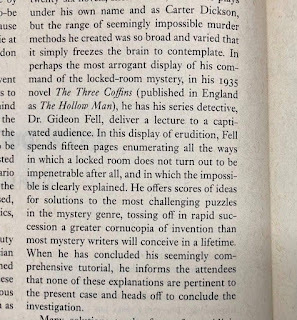 Incidentally, The Black Spectacles has a fun segment about the mental makeup and methods of the “male poisoner” – drawing on famous real-life cases such as those of EW Pritchard, TG Wainewright and Thomas Neill Cream – that reminded me of the Locked Room Lecture. Not as elaborate, but wry and informative, even as Gideon Fell is being his exasperating self.
Incidentally, The Black Spectacles has a fun segment about the mental makeup and methods of the “male poisoner” – drawing on famous real-life cases such as those of EW Pritchard, TG Wainewright and Thomas Neill Cream – that reminded me of the Locked Room Lecture. Not as elaborate, but wry and informative, even as Gideon Fell is being his exasperating self.P.P.S. perhaps my favourite Carr novel so far is She Died a Lady, a very good mystery on its own terms, with a typically confounding premise (two adulterous lovers appear to have walked to the edge of a cliff and thrown themselves off it – the footprints confirm this beyond a doubt – but when the bodies are recovered, it turns out they were *first* shot and killed at close range!) – but equally fascinating is a narrative ploy that makes the book a very interesting companion piece to one of Agatha Christie’s most famous works. Not saying more.
August 8, 2025
Sholay, in fragments: a 50th anniversary tribute
[Wrote a version of this piece for Mint Lounge, as part of a tribute to Sholay on its 50th anniversary. Have written about the film before, of course – including a 40th anniversary piece which you can read here – and it doesn’t feel like much new can be said. But I took a personal slant here, likening the film to a famous oral epic, imagined and experienced in bits and pieces, never quite “finished”]
----------------------------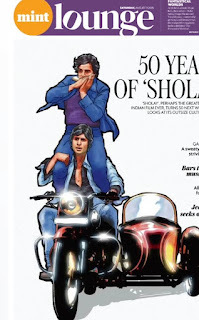 Is it possible for the most iconic and mythologised film in your life – the one that is most thoroughly familiar – to also feel like a jigsaw puzzle that took a long time to put together?
Is it possible for the most iconic and mythologised film in your life – the one that is most thoroughly familiar – to also feel like a jigsaw puzzle that took a long time to put together?
Like any other super-fan, I have my personal Sholay history, and it includes this confession: even though the film is central to my pop-cultural journey, looming forever on the horizon like those boulders against the sun in Gabbar’s domain, there have been many gaps in my viewing. Of course I have watched it in the conventional way from beginning to end, at least five or six times (as opposed to the dozens or hundreds claimed by other devotees) – and yet it always feels like I came to it piecemeal through a melange of things heard and read, narratives constructed, back-stories related in magazines and books… and finally, prints with scenes missing in them.
Here’s how this can happen.
****
You’re six or seven, and going for a rare family outing to a hall, to see a film that’s less than a decade old but already fixed in legend. Someone dawdles, you reach 10 minutes after the show has begun, walking into a noisy action sequence involving a train, bad guys on horses, and three leading men whom you recognise. It’s exciting but you’re overwhelmed, and lost about who is doing what: why is one of the “heroes” in police uniform while the other two look roguish, though they all appear to be fighting on the same side?
Then, in the very next scene, Sanjeev Kumar – the cop on the train, energetic and youthful – is older, tired, speaking slowly. You’re not sure what’s going on: the concept of the flashback and flashforward, the idea that these images can jump rudely from one period to another, is not something you have fully assimilated. Anyway, a few moments later the other heroes, Dharmendra and Amitabh (your childhood crushes), looking the same as before, are goofing around on a bike, singing, clowning about in jail.
It’s a night show, you may be drifting off now and again. The spectre of Gabbar Singh arrives: first his name, spoken fearfully many times, and later the man himself. But even amidst the terror of his first appearance, with the minatory music and the belt being dragged along the rocks, you feel confusion: you think he resembles one of the dacoits on horseback – curly-haired, green shirt – from that train scene, and wonder if there’s a link you missed.
A mid-film flashback where Sanjeev Kumar is young again. Through blurry eyes you register the shifts: black moustache to grey moustache, hands to no hands, police uniform to sombre shawl. Later, a fragmented viewing at someone’s house will leave you with more confusion about the two major flashbacks, and more questions about the sequence of events. 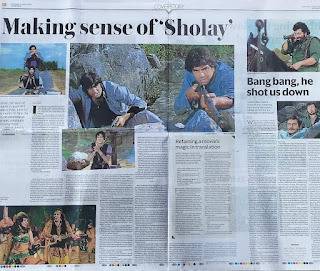 Which is to say that there was a time in my childhood when the plot of Sholay was as much of a maze as a convoluted David Lynch or Christopher Nolan film might be.
Which is to say that there was a time in my childhood when the plot of Sholay was as much of a maze as a convoluted David Lynch or Christopher Nolan film might be.
Navigating the labyrinth was complicated by the fact that for a while it was done simultaneously along two mediums: listening to the famous double audio-cassette of the film’s dialogue, and watching a videotape that was much cherished but also problematic.
The audio-cassette was unnerving: you had to identify characters by their voices; it didn’t feature entire songs, playing only the first couple of bars of each familiar tune, before returning to the prose scenes. Some excitement lay in the details – I was tickled to bits by the line “Thakur ne hijron ki fauj banayi hai”, not having expected to hear a word like that in a film – but on balance I preferred to watch Sholay, not hear it.
The videotape, one of my favourite childhood possessions, came for some reason from faraway Lagos, brought by a visiting uncle who had been assured that the thing I wanted most in the world was my own Sholay cassette. I was ten now, we had just got a video player at home, and I must have worn it out over days with this tape. The train flashback now made sense to me, as did the overall chronology (though there was still some disorientation in, for instance, seeing Gabbar’s henchman Kaalia alive and gloating in a flashback after he had been bumped off in that sadistic roulette scene).
At last I was getting to watch the complete film, from start to finish. Or so I thought.
There were abrupt cuts here and there, especially in the first hour – it took some time to realise that chunks had been snipped to fit the VHS’s 180 minutes. Which meant that years after my first, mysterious hall viewing as a small child, some things still had to be figured out.
Sleuthing, carefully matching the video footage with the audio on my dialogue-cassette, I realised that the scenes involving Soorma Bhopali (Jagdeep) and the Hitler-like jailer (Asrani) had been excised in the former. That makes some sense if you have to cut 15 minutes: those sequences are fun and show off the skills of two fine character actors, but they are dispensable to the main narrative, and they greatly delay Veeru and Jai’s arrival in Ramgarh.
Even so, I feel cheated that it took me years, maybe decades, to realise that the beloved Keshto Mukherjee had a small role in Sholay (in the jailer scene).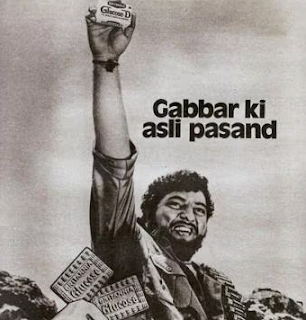 Things were also complicated by the fact that Sholay’s characters were continuing with their lives in other forms and media. Gabbar Singh was selling glucose biscuits in ads long after he had been vanquished (or killed, in the ending that was shot but not released). In the late 1980s came a film called Soorma Bhopali with Jagdeep, featuring Dharmendra and Bachchan in cameos unrelated to their Sholay roles; after that, Ramgarh ke Sholay, which seemed cheap and B-grade-ish, being filled with star-impersonators, but which still had the real Amjad Khan (looking much paunchier, as if Gabbar had taken his role as biscuit mascot too seriously).
Things were also complicated by the fact that Sholay’s characters were continuing with their lives in other forms and media. Gabbar Singh was selling glucose biscuits in ads long after he had been vanquished (or killed, in the ending that was shot but not released). In the late 1980s came a film called Soorma Bhopali with Jagdeep, featuring Dharmendra and Bachchan in cameos unrelated to their Sholay roles; after that, Ramgarh ke Sholay, which seemed cheap and B-grade-ish, being filled with star-impersonators, but which still had the real Amjad Khan (looking much paunchier, as if Gabbar had taken his role as biscuit mascot too seriously).
*****
Between all this, during my video viewings, Sholay did perform the epiphanic functions that a landmark film is expected to. For instance, I can never forget the tense scene where the villagers turn hostile towards their mercenary protectors, because this was the moment when the idea first entered my nascently movie-obsessed head that a camera movement is a deliberate, engineered thing that builds meaning: when the line “Kab tak jeeyoge tum, aur kab tak jeeyenge hum, agar yeh dono iss gaon mein rahe?” (“How long will we stay alive if these two remain in the village?”) is accompanied by a camera swish that places Veeru and Jai at the centre of the frame, precisely on the words “yeh dono”.
I learnt about the mysteries of personality too, and how a creative work can bring catharsis or draw out aspects of yourself that you hadn’t fully processed yet. As a painfully shy and quiet child with a taste for sardonic humour, there was every reason for me to relate to Bachchan’s Jai; instead I was always more drawn to, and even felt a kinship with, the boisterous Veeru.
But that Nigerian tape was also responsible for the biggest of my Sholay gaps – one I was unaware of until well in my thirties. That’s how old I was when I watched Sholay’s great opening-credits sequence for the very first time. While that might not be a big deal for most Hindi films of the period, in Sholay the craft and attention to detail begins right here – in the scene where the manservant Ramlal leads a policeman on horseback from the railway station to the Thakur’s haveli.
My tape had the credits only until the names of the six principal actors; there was a sudden cut after the title "And Introducing Amjad Khan". This is a major bone I have to pick with the anonymous tape-editor sitting, in my mind’s eye, in some squalid little Lagos bootleggers’ shop. Because, watching the full sequence on DVD decades later, I saw how it sets the stage, giving us a detailed view of Ramgarh and its surroundings, long before the narrative actually takes us there. The superb RD Burman background score changes from a guitar-dominated tune as the riders move through a barren, American Western-like setting to a more Indian sound, with mridangam and taar shehnai, as they pass through the village. The symbolic nature of Sholay’s mise-en-scene is made obvious here too, with the contrast between swathes of rough landscape (where the dacoits, creatures of the wild, perch like vultures) and the village, where people live together in an ordered community – a setting that will soon welcome two rootless men who will learn about taking on responsibility and integrating into a larger world.
So here was a clear case of me watching a segment of Sholay as an adult with no pre-conceptions, seeing something new and being utterly impressed. When I screened and discussed the sequence in classes, the discussions were perceptive, intense and wide-ranging – even when they involved students who had never actually watched the film. (Yes, there are now many such movie buffs.)
It is widely acknowledged that Sholay was the most polished and fully realised of the Hindi films of its era, the most flawless technically, the one with the best action scenes and sound design, the fewest loose ends or awkward cutting. The sort of mainstream film that even Satyajit Ray could (grudgingly?) admire. But however complete it may be, I think of it as a series of unforgettable moments that are so deeply embedded in one’s consciousness (and so easily accessed from the mind’s old filing cabinet) that it almost doesn’t matter which order those fragments come in – there are any number of entry points. It’s a bit like knowing key sections of a legendary epic – say, the Mahabharata – and still feeling like you know it in its entirety. But the possibility of being surprised by a detail here, or a fresh re-watch, still exists, even for old fans who thought there was nothing more to learn.
July 22, 2025
An online chat with Imogen Sara Smith
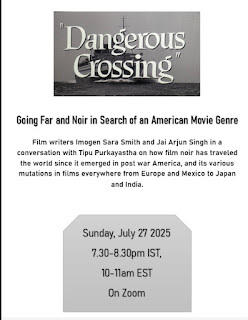 So noir yet so far: my friend Tipu Purkayastha and I will be in conversation with the writer and film scholar Imogen Sara Smith on July 27 – it’s open to all, so please try to join. Imogen has written on many things (including a book on Buster Keaton and some fine essays on the Criterion Collection website), but the topic for this discussion is film noir as it has travelled outside America – moving from its gritty urban contemporary roots to different locales, languages and sensibilities. Including, of course, the Indian version of noir as manifested in old Hindi cinema (e.g. the Navketan films of the 1950s) as well as the neo-noir of more recent decades.
So noir yet so far: my friend Tipu Purkayastha and I will be in conversation with the writer and film scholar Imogen Sara Smith on July 27 – it’s open to all, so please try to join. Imogen has written on many things (including a book on Buster Keaton and some fine essays on the Criterion Collection website), but the topic for this discussion is film noir as it has travelled outside America – moving from its gritty urban contemporary roots to different locales, languages and sensibilities. Including, of course, the Indian version of noir as manifested in old Hindi cinema (e.g. the Navketan films of the 1950s) as well as the neo-noir of more recent decades. Please DM me (or email at jaiarjun@gmail.com) for the Zoom link.
July 21, 2025
A short recommendation: The Beast Within
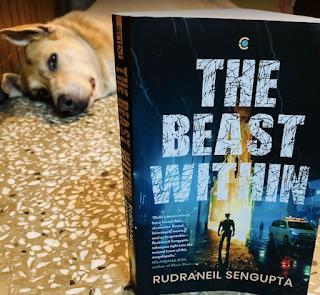 Putting up a few short posts about books I haveenjoyed in the past year, which I have mentioned elsewhere but not here.One of them is RudraneilSengupta’s crime novel The Beast Within, about a police investigation centredaround a suspicious death in Delhi’s Panchshila Park. (This, incidentally, hitsa little too close to home, given that I have a new flat in that colony *and*there has been a spate of crime in Panchshila in recent times, including amurder.)
Putting up a few short posts about books I haveenjoyed in the past year, which I have mentioned elsewhere but not here.One of them is RudraneilSengupta’s crime novel The Beast Within, about a police investigation centredaround a suspicious death in Delhi’s Panchshila Park. (This, incidentally, hitsa little too close to home, given that I have a new flat in that colony *and*there has been a spate of crime in Panchshila in recent times, including amurder.) The Beast Within isn’t a mystery so much as aprocedural that goes in many different directions, with a team of cops having todeal with – among other things – pressure and bullying from the well-heeled andthe well-connected. I particularly liked the pacing and the continuous shift ofperspectives between the policemen (and one policewoman, the book’s mostendearing character, a former wrestler named Meera Kumari), with their approachto the investigation being rooted in their backgrounds, biases andpersonalities.
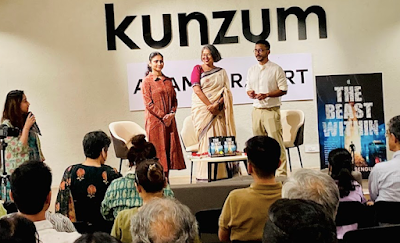 I couldn’t attend all of Rudraneil’s recent bookdiscussion (featuring author Madhulika Liddle and Monika Bhardwaj, the first womanDCP in the Delhi Crime Branch – a pic from that here) but I did get to brieflymeet him there. We had first been in touch during Covid times because of ourshared activities in street-animal care, and the book has a couple of passageswhere Meera – an animal-friend herself – explodes at people who are rantingabout the “stray dog menace”. Very relatable. Lara (seen above), Chameli and others would like this fictional woman cop, I think.
I couldn’t attend all of Rudraneil’s recent bookdiscussion (featuring author Madhulika Liddle and Monika Bhardwaj, the first womanDCP in the Delhi Crime Branch – a pic from that here) but I did get to brieflymeet him there. We had first been in touch during Covid times because of ourshared activities in street-animal care, and the book has a couple of passageswhere Meera – an animal-friend herself – explodes at people who are rantingabout the “stray dog menace”. Very relatable. Lara (seen above), Chameli and others would like this fictional woman cop, I think.
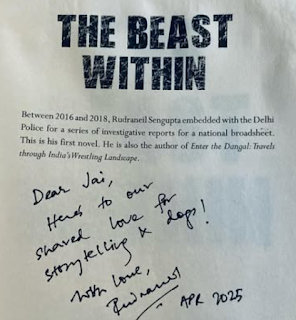
<font size="4"><span style="font-family: trebuchet;">@font-face {font-family:"Cambria Math"; panose-1:2 4 5 3 5 4 6 3 2 4; mso-font-charset:0; mso-generic-font-family:roman; mso-font-pitch:variable; mso-font-signature:-536870145 1107305727 0 0 415 0;}@font-face {font-family:Calibri; panose-1:2 15 5 2 2 2 4 3 2 4; mso-font-charset:0; mso-generic-font-family:swiss; mso-font-pitch:variable; mso-font-signature:-536859905 -1073732485 9 0 511 0;}@font-face {font-family:AppleSystemUIFont; panose-1:2 11 6 4 2 2 2 2 2 4; mso-font-alt:Calibri; mso-font-charset:0; mso-generic-font-family:auto; mso-font-pitch:auto; mso-font-signature:3 0 0 0 1 0;}p.MsoNormal, li.MsoNormal, div.MsoNormal {mso-style-unhide:no; mso-style-qformat:yes; mso-style-parent:""; margin:0cm; mso-pagination:widow-orphan; font-size:12.0pt; font-family:"Calibri",sans-serif; mso-ascii-font-family:Calibri; mso-ascii-theme-font:minor-latin; mso-fareast-font-family:Calibri; mso-fareast-theme-font:minor-latin; mso-hansi-font-family:Calibri; mso-hansi-theme-font:minor-latin; mso-bidi-font-family:"Times New Roman"; mso-bidi-theme-font:minor-bidi; mso-fareast-language:EN-US;}.MsoChpDefault {mso-style-type:export-only; mso-default-props:yes; font-family:"Calibri",sans-serif; mso-ascii-font-family:Calibri; mso-ascii-theme-font:minor-latin; mso-fareast-font-family:Calibri; mso-fareast-theme-font:minor-latin; mso-hansi-font-family:Calibri; mso-hansi-theme-font:minor-latin; mso-bidi-font-family:"Times New Roman"; mso-bidi-theme-font:minor-bidi; mso-fareast-language:EN-US;}div.WordSection1 {page:WordSection1;}</span></font>
July 20, 2025
Trivandrum diary: meeting Karthika (and a few dogs)
From earlier this month… my dear friend (and fabulous writer and poet and fellow mythology buff and cinephile and all-round inspiration) Karthika Nair couldn’t make it to Delhi during her recent India trip, so I hopped down to Trivandrum to see her on her home turf - in the quiet and picturesque Vellayani Lake area. It was great to spend an afternoon talking about this and that, and to meet her family. (Including the dogs who, after some initial yelling, recognised me as the alpha dog I am and paid respectful tribute.)
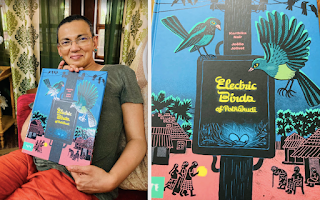 I also looked through the beautiful book Electric Birds of Kothapudi, a modern fable written by Karthika (I had read an early draft of it a couple of years ago) and brilliantly illustrated by Joelle Jolivet. The book isn’t published in India yet, but it really should be - fingers crossed.
I also looked through the beautiful book Electric Birds of Kothapudi, a modern fable written by Karthika (I had read an early draft of it a couple of years ago) and brilliantly illustrated by Joelle Jolivet. The book isn’t published in India yet, but it really should be - fingers crossed.
A couple of pics from the book are below, and here is a post about another superb collaboration between Karthika and Joelle, The Honey Hunter. And a conversation with Karthika and Sampurna Chattarji about their book Over and Under Ground in Paris & Mumbai, which also had drawings by Jolivet and Roshni Vyam.
(Last few photos: at the end of a long, long early-morning walk around Kovalam, I found myself at the lighthouse beach, where this black-and-white fellow contemplated me a little fearfully. Glad to see that "progressive" Kerala hasn’t slaughtered all of its community dogs yet - I also found a few lazing on the beach outside the Uday Samudra resort. Sand, shadow and sleeper in the last pic.)
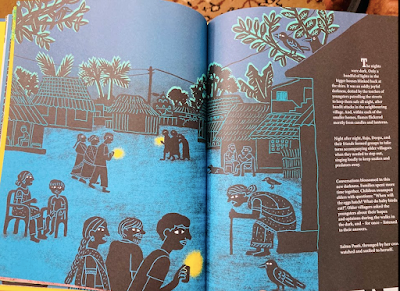
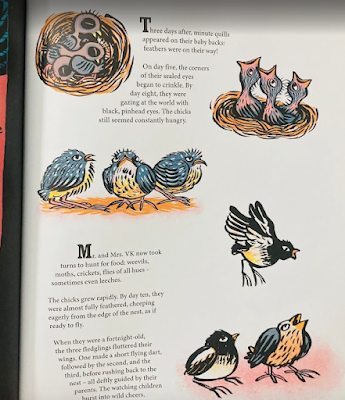





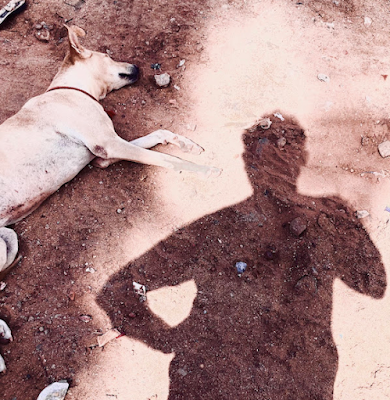
(A long conversation with Karthika about her superb Mahabharata book Until the Lions is here)
July 18, 2025
Wicked game to play: an unexpected cameo in Silence of the Lambs
I re-watched Silence of the Lambs a few weeks ago and had a few thoughts about it – including a memory-trigger of my strangely bifurcated first viewing of the film in 1991: my mother and I watched a little more than half of it together at night on cassette, and then finished it early the next morning before I left for school! A very strange thing to do with this film. We may have been awkwardly silent during the full-frontal-nudity scene where Buffalo Bill, having tucked his penis behind his legs to make himself look female, sways about in front of the camera.
I find I’m not too impressed any more by Anthony Hopkins’s performance as Hannibal Lecter. (I know it isn’t fair to compare the three on-screen Lecters, given that they serve such different functions in their respective films/shows – but I think Brian Cox in Manhunter has a matter-of-fact menace that Hopkins doesn’t. Mads Mikkelsen in the TV series of course gets to develop many shades of the character over dozens of episodes, so maybe *that* isn’t a meaningful comparison at all.) Jodie Foster is excellent though, and makes it easy to see that Clarice is the clear protagonist of the film (and the book), in much the same way that Will Graham is the protagonist of Red Dragon and its film versions.
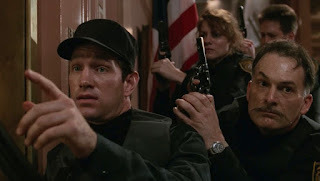 Anyway, here’s a more unexpected observation: in the scene where Lecter escapes, there is an actor playing a SWAT team leader who I thought was the spitting image of Chris Isaak. Then I looked it up and discovered that it *was* Chris Isaak. Surprising. It’s a very brief part but he is convincing enough in it.
Anyway, here’s a more unexpected observation: in the scene where Lecter escapes, there is an actor playing a SWAT team leader who I thought was the spitting image of Chris Isaak. Then I looked it up and discovered that it *was* Chris Isaak. Surprising. It’s a very brief part but he is convincing enough in it.
Unfortunately, now whenever I think of Silence of the Lambs, the song “Wicked Game” will play in my head…
July 17, 2025
Om and Kirk, in intense close-up
[Just a casual little post, of the sort I haven’t been putting here in a long time – these updates end up going on Instagram, or less frequently, Facebook. Will try to post a few more here]
------------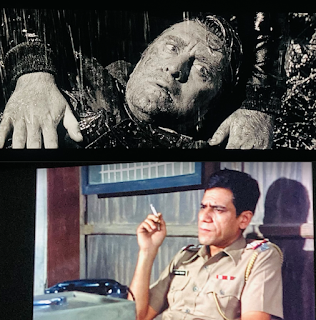 Two incredible faces, holding the frame in a number of arresting close-ups – in two films I just watched on big screens. Above: Kirk Douglas in Lonely are the Brave; below, Om Puri in Ardh Satya. Both play characters (on opposite sides of the law) who are dealing with alienation, humiliation, and uncertainty about how to move forward, or where to go, in a world that seems unable to accommodate their value system.
Two incredible faces, holding the frame in a number of arresting close-ups – in two films I just watched on big screens. Above: Kirk Douglas in Lonely are the Brave; below, Om Puri in Ardh Satya. Both play characters (on opposite sides of the law) who are dealing with alienation, humiliation, and uncertainty about how to move forward, or where to go, in a world that seems unable to accommodate their value system.
I have had mixed feelings about Ardh Satya earlier, and that continued here (though this was easily the best print I have watched) – while it is full of powerful little moments and performances, something has always felt a bit off to me in the pacing; a few loose-limbed moments detract from the intensity of the central narrative, it isn’t anywhere near as tight as my favourite Nihalani film Party (though in fairness I haven’t watched that one in a long time, so who knows how I will feel about it now). Also, I have many sharp things to say to people who hold this film up as a shining beacon to run down the more mainstream angry-cop films of the period – but this is not the space to vent about that.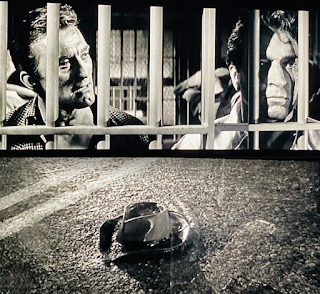 And about Lonely are the Brave, watched in my new screening room in Panchshila Park with a few friends… this was a super experience, one of the most unusual transitional Westerns from a period that bridged the classical and post-modern versions of the genre, between Ford/Hawks and Peckinpah/Leone. I was afraid it would be too low-key for a big-screen viewing, but it wasn’t – it is marvellously shot (in Panavision, 2.35:1) by Philip Lathrop, and with some beautiful landscapes and a final scene in the rain that’s comparable in its framing with the great last shot (another Kirk Douglas close-up) of Billy Wilder’s Ace in the Hole.
And about Lonely are the Brave, watched in my new screening room in Panchshila Park with a few friends… this was a super experience, one of the most unusual transitional Westerns from a period that bridged the classical and post-modern versions of the genre, between Ford/Hawks and Peckinpah/Leone. I was afraid it would be too low-key for a big-screen viewing, but it wasn’t – it is marvellously shot (in Panavision, 2.35:1) by Philip Lathrop, and with some beautiful landscapes and a final scene in the rain that’s comparable in its framing with the great last shot (another Kirk Douglas close-up) of Billy Wilder’s Ace in the Hole.
Bonus pic below: one of the Ardh Satya posters gifted to me by Manjula Padmanabhan, who did those superb drawings of Om, Smita, Amrish Puri and Sadashiv Amrapurkar. (The dedication says "With many Jellyfish" - a reference to the essay Manjula wrote for me for The Popcorn Essayists.)

P.S. an old post on Nihalani and Om Puri is here. And another great poster by Manjula can be seen in this post.
July 11, 2025
On savouring the restored Umrao Jaan, and going down nostalgia street
[From my Economic Times column]
---------------
An important trope of the Hindi cinema I cherished as a child – the action-oriented, male-centred films – was the one where a weepy-faced boy would dramatically morph into the adult star 15 minutes into the narrative. Sometimes it happened during a chase scene: the child actor’s legs would turn into sturdier, jeans-clad ones, a boy would jump off a bridge and land on a train as the dashing hero. Or a match cut or camera swish might render Master Mayur into Amitabh Bachchan, and the whistles and yells of approvals could begin. 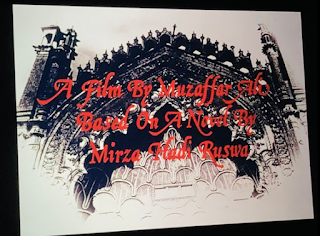 I was amusingly reminded of those scenes while watching the excellent restoration of Muzaffar Ali’s 1981 Umrao Jaan on a big screen recently. Mid-dance (or mid-twirl) the young girl Ameeran – sold into a Lucknow brothel and renamed Umrao – turns into the adult version of the character, played by Rekha. To my mind, this scene was as star-heralding in its own way as the ones I mentioned above. (In even the relatively grounded Middle Cinema of the period, you could expect a burst of sparkly music upon the first appearance of a protagonist played by Sanjeev Kumar or Jaya Bhaduri.) But Umrao Jaan is, of course, a very different sort of film otherwise from my childhood favourites, and I found myself rapt by this languid, introspective, woman-centric narrative – in a way that I wasn’t as a youngster. This must be what it’s like to grow up.
I was amusingly reminded of those scenes while watching the excellent restoration of Muzaffar Ali’s 1981 Umrao Jaan on a big screen recently. Mid-dance (or mid-twirl) the young girl Ameeran – sold into a Lucknow brothel and renamed Umrao – turns into the adult version of the character, played by Rekha. To my mind, this scene was as star-heralding in its own way as the ones I mentioned above. (In even the relatively grounded Middle Cinema of the period, you could expect a burst of sparkly music upon the first appearance of a protagonist played by Sanjeev Kumar or Jaya Bhaduri.) But Umrao Jaan is, of course, a very different sort of film otherwise from my childhood favourites, and I found myself rapt by this languid, introspective, woman-centric narrative – in a way that I wasn’t as a youngster. This must be what it’s like to grow up.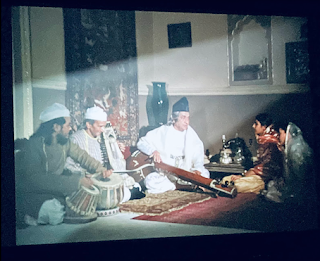 There was so much to absorb and savour here: the songs most obviously, the costumes and sets, the interactions between assertive women and effeminate or suppliant men. Or little details such as the tribute-casting of the veteran Bharat Bhushan (who had once played both Baiju Bawra and Tansen on screen) in a small part. Or the realisation that the child Ameeran here is played by the daughter of Shama Zaidi and MS Sathyu.
There was so much to absorb and savour here: the songs most obviously, the costumes and sets, the interactions between assertive women and effeminate or suppliant men. Or little details such as the tribute-casting of the veteran Bharat Bhushan (who had once played both Baiju Bawra and Tansen on screen) in a small part. Or the realisation that the child Ameeran here is played by the daughter of Shama Zaidi and MS Sathyu.
Much has probably been said about female solidarity (commingled with female conflict) in Umrao Jaan – about the balancing of scales not just between the sexes but also among women; about their interrelationships in precarious situations, where vulnerability goes hand in hand with the exercising of dignity and power. Dim childhood memories had fixed this as a story about Lucknowi tehzeeb – soulful poetry and music taking precedence, even in a setting where women’s bodies are traded; a world where even a wild-eyed bandit might be respectful towards the heroine – but the actual film is more dynamic and varied than that, and gets much of its impact from the profane moments that joltingly remind us where we are: the unexpected use of the word “randi” in an exchange, or the veteran Dina Pathak spitting out the line “Aise haraam zaade marte hain kabhi?” 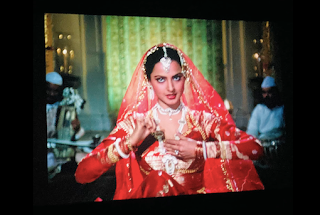 For me, Umrao Jaan is also inseparable from my shifting view of Rekha, who was not one of my favourites as a child – I saw her as one of Bachchan’s less interesting heroines (not as sophisticated or modern as Parveen Babi, not as naturally sweet as Jaya Bhaduri or as unconventional as Raakhee), and my interest in her tawaif roles was limited to Muqaddar ka Sikander. But over time, this yielded to a greater interest in the maternal aspect of the Rekha persona, as well as the image – supplied in 1980s and 90s film magazines – of the woman living in solitude, childless, partner-less, her closest companion a beloved dog who often appeared in those pages**. One’s view of the bereft Umrao Jaan can be deepened by what one knows (or thinks one knows) of Rekha’s real life – including her being cut off from a secure family life early on (much as Umrao is) despite being the child of a superstar.
For me, Umrao Jaan is also inseparable from my shifting view of Rekha, who was not one of my favourites as a child – I saw her as one of Bachchan’s less interesting heroines (not as sophisticated or modern as Parveen Babi, not as naturally sweet as Jaya Bhaduri or as unconventional as Raakhee), and my interest in her tawaif roles was limited to Muqaddar ka Sikander. But over time, this yielded to a greater interest in the maternal aspect of the Rekha persona, as well as the image – supplied in 1980s and 90s film magazines – of the woman living in solitude, childless, partner-less, her closest companion a beloved dog who often appeared in those pages**. One’s view of the bereft Umrao Jaan can be deepened by what one knows (or thinks one knows) of Rekha’s real life – including her being cut off from a secure family life early on (much as Umrao is) despite being the child of a superstar.
But there is also something about watching an old, familiar film alongside someone with whom you have a long, complex history. My viewing companion and I have been in a strained relationship, imbued with sadness and separation – and yet when it came to little observations or childhood-memory-triggers around the film, we leant in and whispered to each other, as unselfconsciously as in the good old days. Compare Rekha and Naseer with their roles in Ijaazat later in the decade; look at how “seedha” Farooque Shaikh is here and how “tedha” Naseer is, in contrast to their roles in Katha; how much the Shabana Azmi of the present day resembles her mother Shaukat Kaifi (who plays the kotha madam Khanum Jaan). For a few moments, a shared experience of a film, and the many memories associated with it, had transported us back to a time and space when things were gentler between us. Maybe that’s why they call it a restoration.
----------------------------------
**P.S. Recently the actress Trisha Krishnan's dog died and she wrote an Instagram post saying simply "I have lost my son", with a video. It was a very brave thing for her to do on social media, because you can imagine the vicious trolling in the comments, including from people who were supposedly her fans but said they wouldn't follow her now because "how can you compare an animal to a human kid" etc. It was horrendous, and also predictable. Anyway, I was reminded of Rekha in those magazine interviews referring to her Pomeranian Pisti as her child, and one of my mother’s visiting friends saying something utterly nasty like "jab khud ka asli bachha nahin hota toh aise bakwaas karte hain".
June 11, 2025
A tribute to Raj Kapoor as one of our finest song-actors
[Wrote this piece for a special, Raj Kapoor-themed issue of Frontline magazine]
-----------------
This is something every serious cineaste knows: most films of a certain vintage – especially those made by a director with a sense of visual composition, movement and use of space – are very different beasts when viewed on a big screen in a dark hall. This is also true of melodrama, of the larger-than-life movie that reaches for heightened emotion and grand gesture, the sort of thing that can make a modern viewer, weaned on “realism”, squirm – but which seen in the right environment reveals all its emotional depths and layers. Allowing even the most rational of us to tap into the mysterious, atavistic sides of our own personalities – to be stirred in ways that a grittier work may not achieve. 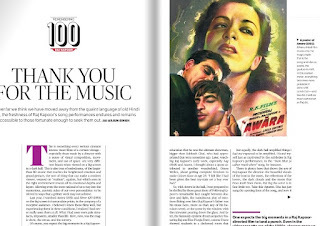 Last year I watched Awaara and Shree 420 on a big screen in immaculate prints, in the company of a receptive audience. I believed I knew these films well; but experiencing them in these conditions, I realised I had never actually seen them at all. What I had seen were pale simulacra – imposters, smaller than life. Here, now, was the magic show, the circus, the sorcery.
Last year I watched Awaara and Shree 420 on a big screen in immaculate prints, in the company of a receptive audience. I believed I knew these films well; but experiencing them in these conditions, I realised I had never actually seen them at all. What I had seen were pale simulacra – imposters, smaller than life. Here, now, was the magic show, the circus, the sorcery.
Of course, you expect the Big Moments in a Raj Kapoor-directed film to land a punch. Even in the videocassette era of the 1980s, my generation of viewers grew up with the education that he was the ultimate showman, bigger than Subhash Ghai who had recently appropriated that term. Later, watching RK’s early work, especially Aag and Awaara, I thought about a quote attributed to another wunderkind, Orson Welles, about getting complete freedom to make Citizen Kane at age 25: “I felt like I had been given the best toy-train set a boy ever had.”
So, with Awaara in the hall, I was prepared to be thrilled by those great shots of Prithviraj Kapoor’s remarkable face caught between shadow and light, the tumultuous play of emotions flitting over him (Raj Kapoor’s father was his Muse here, more so than any of his heroines were), or the scene by the window with the rain-water pouring down the glass. And later, the famously opulent dream sequence featuring Raj and Rita (Nargis) – a scene I have showed students in a darkened room that could only partly replicate the big-screen experience.
But equally, the dark hall amplified things I hadn’t expected to be amplified. I found myself just as captivated by the subtleties in Raj’s performance – in the “Dam bhar jo udhar munh phere” scene, for instance.  There is plenty here that shows the eye of Kapoor the director: the beautiful visuals of the boat in the water, the reflections of the lovers, the dark clouds and the moon that frees itself from them. But Raj the actor is in full fettle too. Take this vignette. Rita has just sung the opening lines of the song, and now it is his turn. The camera switches to his face as she concludes “… baatein hazaar kar loongi”, and in those couple of seconds we see him moving his lips silently to her singing – before commencing his part.
There is plenty here that shows the eye of Kapoor the director: the beautiful visuals of the boat in the water, the reflections of the lovers, the dark clouds and the moon that frees itself from them. But Raj the actor is in full fettle too. Take this vignette. Rita has just sung the opening lines of the song, and now it is his turn. The camera switches to his face as she concludes “… baatein hazaar kar loongi”, and in those couple of seconds we see him moving his lips silently to her singing – before commencing his part.
This can be interpreted in diegetic terms: a young man appreciatively mouths the words to his girlfriend’s song, in kinship. Or it could be Raj Kapoor – connoisseur of music, maintaining full control over his vision – lost in the moment, counting the beats before his own lip-synching. Either way, it works beautifully. It is one of those small moments (in a grandstanding, symbolism-laden film) that the critic Manny Farber alluded to when he described a non-essential gesture by Humphrey Bogart (in The Big Sleep) bringing alive a whole world outside the specificities of the film’s narrative.
But also note how the ground has been prepared for Raj’s silent lip-moving earlier, in a playful little exchange before the song begins, a melody of “Hmms” and “Uhhs”, where Rita and Raj’s voices almost overlap. (She is trying to find out what he is thinking about, he is replying distractedly; he is passionate about her but also melancholy and uncertain, conflicted about his circumstances.) In the song sequence itself, Nargis is in the disadvantaged position of performing gyrations and coquettish gasps to express girlish enthusiasm (including what looks like a mercifully truncated pole dance of sorts) – but the scenario allows Raj to be introspective, and what he achieves here is something rare: a quiet psychological realism in performance, even while operating within the contours of an upbeat romantic song (the sort of number that literal-minded viewers refer to as synthetic).  “Dam bhar ke” represents a Raj Kapoor skill-set that one tends to overlook. When we think of Raj the actor, we don’t think of subtlety: we think of the displays of animal passion in romantic scenes (even the “Dam bhar ke…” scene was preceded by Raj smacking Rita around), or showy self-pity mixed with KA Abbas-penned lectures about the state of the world. But here is an inward-looking restraint, something Raj did rarely, but very effectively: another example is in the “Duniya Banane Waale” scene in Teesri Kasam, where he is as subdued as Waheeda Rehman, as he sings gently for her.
“Dam bhar ke” represents a Raj Kapoor skill-set that one tends to overlook. When we think of Raj the actor, we don’t think of subtlety: we think of the displays of animal passion in romantic scenes (even the “Dam bhar ke…” scene was preceded by Raj smacking Rita around), or showy self-pity mixed with KA Abbas-penned lectures about the state of the world. But here is an inward-looking restraint, something Raj did rarely, but very effectively: another example is in the “Duniya Banane Waale” scene in Teesri Kasam, where he is as subdued as Waheeda Rehman, as he sings gently for her.
****
When it comes to the more flamboyant Raj Kapoor, the man with the flourishes – running the gamut from Chaplin-esque slapstick to Chaplin-esque pathos and beyond – it is obvious why a song sequence provided a full canvas for him. In a straightforward dramatic scene with regular dialogues, Raj could become a bit hard to take – even if he was being truthful to a loud character. In such cases a viewer’s sympathy can easily veer towards the quieter, more understated performer – say, Dilip Kumar in Andaz, or Ashok Kumar in Bewafa, or even Rajendra Kumar in Sangam. But when a Hindi film moves into the magic realm that is the song-and-dance scene, the bench-posts shift; in this exalted meter, everything becomes more palatable if done with conviction – and few did it with as much conviction as Raj did. Watch “Awaara Hoon”, or “Kisi ki Muskuraahaton Mein”. If this isn’t rigorous acting, what is?
(One can also point out – and apologies if this sounds facile – that Raj’s own voice in normal dialogue scenes could be gratingly whiny when he was playing the narcissistic man-child or the inspirational joker concealing his pain. Mukesh or Manna Dey were easier on the ear.)
In my view there is no equivalent elsewhere in Hindi cinema of an actor-director who so brilliantly filled both roles – behind the camera and in front of it – while orchestrating song sequences. Guru Dutt and Manoj Kumar were, in different ways, very skilled at visualising songs, but neither of them was the song-performer that Raj was. And while this is most evident in the first decade or so of his career – when he was relatively lithe and spry – it can be glimpsed in later films too, including Mera Naam Joker and Dharam Kanta, and even in his small cameo as himself in the “John Jaani Janardan” song in Naseeb, playing the accordion to the delight of the other guests at a film party.
For me, and for many others, Exhibit A of Raj as great song actor is Shree 420’s “Dil ka Haal Sune Dilwala” – which I also had the pleasure of watching on a big screen last year. In a fairer world, I texted a friend after the scene was over, he would have walked off with an Oscar for best actor in a short film.
The sequence has the protagonist, who recently made his way to Bombay, settling down with a group of footpath-dwellers who ask to hear his life-story – which he elaborates through song. But that description doesn’t begin to capture the quality of this extraordinary scene, which builds in tempo – moving seamlessly from the intimate and personal to big-picture motivational speak and social commentary. Much credit must go to the combination of the lyricist Shailendra, music directors Shankar-Jaikishen and the other performers in the scene. But holding it all together, controlling its tempo, is Raj the director – and its beating heart is Raj the actor.  Here he is, drawing on his theatre training in the comical interludes such as the one where he mimics a “budhaa darogaa” (old policeman); then he returns to a more conventional mode, playing a dafli like a romantic hero (or a Mr Tambourine Man of the streets) while a shy young woman dances alongside him. In keeping with the rising pace of the music, he spins the dafli above his head like a sudarshan chakra (or like a playful Abhimanyu using a wheel as a weapon against the world’s slings and arrows), then deftly recovers in time for the song’s next stanza – the one with the hint of pedantry, words of wisdom about the crooked ways of the world, and about the nature and craft of protest. (Meanwhile the rich man in the house nearby has called the police to stop this ruckus.)
Here he is, drawing on his theatre training in the comical interludes such as the one where he mimics a “budhaa darogaa” (old policeman); then he returns to a more conventional mode, playing a dafli like a romantic hero (or a Mr Tambourine Man of the streets) while a shy young woman dances alongside him. In keeping with the rising pace of the music, he spins the dafli above his head like a sudarshan chakra (or like a playful Abhimanyu using a wheel as a weapon against the world’s slings and arrows), then deftly recovers in time for the song’s next stanza – the one with the hint of pedantry, words of wisdom about the crooked ways of the world, and about the nature and craft of protest. (Meanwhile the rich man in the house nearby has called the police to stop this ruckus.)
As the writer and film historian Pavan Jha puts it, this is a classic street anthem and protest song, very Indian in style, with dancing at its heart. Watch Raj’s footwork here – also shown to great effect in “Ichak Daana Beechak Daana” where he combines Little Tramp mannerisms with a Hindi-film-song idiom, tapping and pirouetting from a distance as Nargis sings riddles to children. The repeated tipping of his hat to the children, the cutesy pratfalls and attempts to mimic the Chaplin-duck walk… these can get grating when overdone, but to watch sequences like this one, or “Mera Joota Hai Japani”, is to see how adeptly tics borrowed from an earlier screen God can be incorporated into an Indian form of storytelling, and into a particular cultural milieu. If Raj’s character can sing “my clothes and shoes are from other lands, but my heart and essence are Indian”, this is true of his appropriation of the Chaplin persona too.
*****
In his memoir Khullam Khulla, Rishi Kapoor relates how he had to tell his son Ranbir the importance of actually singing a song on the sets out loud while shooting a musical sequence – as opposed to silently moving his lips, which would dilute the performance’s credibility. Rishi also mentions that during his own years as a leading man, he made an effort to be convincing in musical scenes even when playing instruments that he didn't actually know how to play.
It's easy to posit that this trait came from Raj – apart from the genes he bequeathed to his children Randhir and Rishi, he must also have influenced his younger brothers Shammi (one of our most uninhibited and rambunctious musical performers) and Shashi, who would have watched him as they were coming of age.
In the 1959 Anari – directed by Hrishikesh Mukherjee, but a Raj Kapoor film in many ways, with many of his regular crew-members involved – there is a scene where Raj is finding it hard to express his romantic feelings to Aarti (Nutan) in dry prose; she asks him to sing instead, which is the cue for the song “Dil ki Nazar Se”. Nearly 60 years later, in Jagga Jasoos, his grandson Ranbir plays a stuttering protagonist who needs to sing the things he wants to say, so that it “comes out smooth”. (“Mere words bhi so-so ke nikalte hain / Isliye gaa ke bolta hoon.”)
Whether or not this was a conscious homage, it feels like a symbiotic link between two very different types of cinema, calling out to each other across the decades, bound by a belief in the idea that music and rhythm could achieve things that regular conversation could not. However far we think we have moved from the quaint language of old Hindi films, the freshness of Raj Kapoor’s song performances will remain, and will remain accessible to those lucky enough to seek them out. As the Joker sang, “Jee chaahe jab hum ko awaaz do / Hum hain wahin, hum thay jahaan.”
May 30, 2025
Kaali Dilli, bheegi billi - two films about the chaos that is Delhi
[From my Economic Times column]
Perhaps because I re-watched Woody Allen’s Manhattan recently – with its hysterical and bittersweet love-letter to New York in the opening sequence – I have been thinking about cities in cinema. And in a funny coincidence, last week I watched two unrelated films (each directed by a Dibakar) that begin with an unexpected location title involving Delhi.
Dibakar Banerjee’s Tees, completed in 2022 but under a censorship cloud after being shelved by Netflix, begins with the words “New Delhi, 2043”… placed atop an image of an ocean (of all decidedly non-Delhi things)! Then, as an animated black cat – “Bheegi Billi” – walks towards the camera, we get the punch-line: this is a virtual image, communicating with someone who is physically located in the capital. 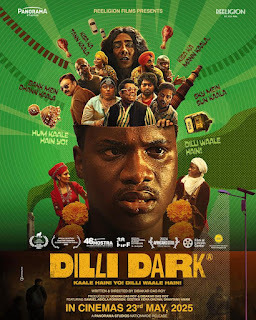 Meanwhile Dibakar Das Roy’s comedy Dilli Dark – currently in halls – opens with a title saying “Dilli, 1240 AD”, along with a view of an idyllic forest. This is a reference to the Razia Sultan story and her supposed romance with a man of African origin – which serves as underlying commentary for a present-day narrative about Michael, a Nigerian who is trying to complete his MBA while negotiating the city’s racism.
Meanwhile Dibakar Das Roy’s comedy Dilli Dark – currently in halls – opens with a title saying “Dilli, 1240 AD”, along with a view of an idyllic forest. This is a reference to the Razia Sultan story and her supposed romance with a man of African origin – which serves as underlying commentary for a present-day narrative about Michael, a Nigerian who is trying to complete his MBA while negotiating the city’s racism.
These are very different types of films, but both show Delhi as a messy, threatening place where no one can completely belong – and which also, in its own weird way can be a pluralistic space when you least expect it.
It would be a stretch to call Tees a Delhi film (in the sense that Banerjee’s brilliant Oye Lucky! Lucky Oye! was) – it is too wide-ranging for that, moving across a number of periods and settings, including the Kashmir of 1989, in its depiction of an India hurtling towards totalitarianism. But some of its most intriguing scenes, the futuristic dystopian ones (which probably played a part in getting the film held back), are set in a Delhi where new AI technology and Third World grime coexist – with images that suggest India will always, for good and for bad, be chaotic.
Dilli Dark is in a clearer way a Delhi movie, with the city as a character – but which version of the city? We get views of the vast AIIMS crossing, cluttered Neb Sarai, the Gyarah Murti statue, and the perspective throughout is that of an outsider. Samuel Abiola Robinson, who plays the lead (he also played the title role in the Malayalam film Sudani from Nigeria years ago), has a charismatic, sympathetic presence that carries the film through even its less inspired moments. At a recent promotional event Robinson mentioned that some of the incidents depicted here came from his real-life experiences as an African in Delhi: exploitation by landlords, police being called on him for no good reason.
Still, I would venture that some of Michael’s dislocation and frustration is relatable even for those of us who have been in Delhi all our lives. Using goofy, irreverent – sometimes bordering on facile – humour, Dilli Dark gets many things right in depicting a city where, as Michael puts it, even two-year-olds learn certain cuss words before they process anything else (and such abuses can be used for anyone, not just Africans); where the topography of the place suggests that something is wrong with its Vaastu-shastra (“Insaan gol gol ghumta jaata hai, bas,” as a character puts it); and in one of the funnier descriptions of the Qutab Minar I have come across. (“Can you imagine the king who made this? It’s like showing a giant middle finger to the sky and saying, tu jaanta nahin mera baap kaun hai?”)
So, Delhi is about swagger and power. But it is also about anarchy, which can have a democratising effect. At one point in Dilli Dark, a city-wide power failure comes to the rescue by plunging everyone – including aggressors – into darkness. In the closing scenes of Tees, madness comes to the Delhi Metro, riding a horse – and one feels that even an autocratic government trying to be all-controlling, like China, can’t strictly regulate everything in a place like this.
As Robinson – sounding affectionate – put it when asked about the difference between working in Kerala and shooting in crowded parts of Delhi: “In Delhi you never know what the f*** will happen.”
[Related posts: Sudani from Nigeria (and other contemporary Malayalam cinema); Oye Lucky! Lucky Oye!]
Jai Arjun Singh's Blog
- Jai Arjun Singh's profile
- 11 followers



